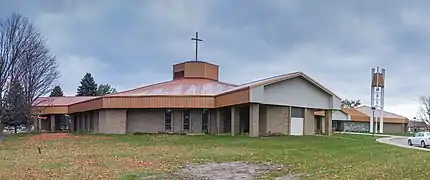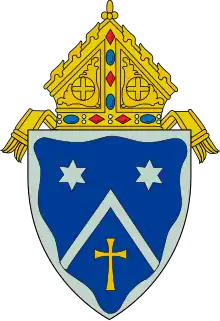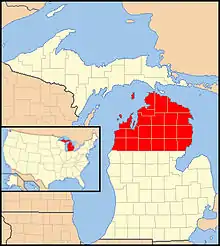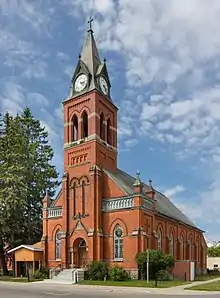Roman Catholic Diocese of Gaylord
The Roman Catholic Diocese of Gaylord (Latin: Diœcesis Gaylordensis) is an ecclesiastical territory or diocese of the Roman Catholic Church in the Northern Michigan region of the United States. It comprises the twenty-one most northern counties of the lower peninsula of the state, and includes the cities of Gaylord, Traverse City, Alpena, Manistee and Petoskey. The fifth bishop is Steven J. Raica.
Diocese of Gaylord Diœcesis Gaylordensis | |
|---|---|
 St. Mary, Our Lady of Mount Carmel Cathedral | |
 Coat of arms | |
| Location | |
| Country | |
| Territory | Counties of Charlevoix, Emmet, Cheboygan, Presque Isle, Leelanau, Antrim, Otsego, Montmorency, Alpena, Benzie, Grand Traverse, Kalkaska, Crawford, Oscoda, Alcona, Manistee, Wexford, Missaukee, Roscommon, Ogemaw, and Iosco |
| Ecclesiastical province | Detroit |
| Statistics | |
| Area | 11,171 sq mi (28,930 km2) |
| Population - Total - Catholics (including non-members) | (as of 2018) 506,623 46,095[1] (9.1%) |
| Parishes | 75 |
| Schools | 17 |
| Information | |
| Denomination | Catholic |
| Sui iuris church | Latin Church |
| Rite | Roman Rite |
| Established | December 19, 1970 (50 years ago) |
| Cathedral | St. Mary, Our Lady of Mount Carmel Cathedral |
| Patron saint | Our Lady of Mount Carmel |
| Secular priests | 76 |
| Current leadership | |
| Pope | Francis |
| Bishop | Sede Vacante |
| Apostolic Administrator | Walter A. Hurley |
| Map | |
 | |
| Website | |
| dioceseofgaylord.org | |
The diocese covers approximately 11,171 square miles (28,930 km2) and has a population of 505,000, 66,000 of whom are Catholic. It contains 77 parishes and 17 schools.[1]
History

Pope Paul VI created the Diocese of Gaylord December 19, 1970 from territory separated from the Dioceses of Saginaw and Grand Rapids, and erected it on July 20, 1971.[1] He named Edmund Szoka as first bishop and the church of St. Mary, Our Lady of Mount Carmel Cathedral (Gaylord, Michigan) as the cathedral.
Bishops
Bishops of Gaylord
- Edmund Casimir Szoka (1971–1981), appointed Archbishop of Detroit and later President of the Prefecture for the Economic Affairs of the Holy See and President of the Pontifical Commission for Vatican City State and Governorate of Vatican City State (elevated to Cardinal in 1988)
- Robert John Rose (1981–1989), appointed Bishop of Grand Rapids
- Patrick R. Cooney (1989–2009)
- Bernard Hebda (2009–2013), appointed Coadjutor Archbishop of Newark and later Archbishop of Saint Paul and Minneapolis
- Steven J. Raica (2014 – March 25, 2020),[2] appointed Bishop of Birmingham
Other priest of this diocese who became bishop
- Chad William Zielinski, appointed Bishop of Fairbanks in 2014
High schools
- Catholic Central High School, Manistee
- St. Francis High School, Traverse City
- St. Mary Cathedral High School, Gaylord
- St. Mary High School, Lake Leelanau
- St. Michael Academy, Petoskey
See also
References
- "About Our Diocese". Diocese of Gaylord. Retrieved 2016-03-16.
- "Transition of Bishop Raica Information - Diocese of Gaylord". www.dioceseofgaylord.org. Retrieved 2020-04-10.
External links
 |
|